

The alphabet is the chief instrument of conventional literacy. Children and other beginning readers are introduced to reading and writing through alphabetic instruction. But learning the “ABCs” is also a process through which cultural norms, morals, instruction about decorum, gender and class roles, and the nature of national and personal identity are communicated.
The Children’s Book Collection in the Young Research Library at UCLA contains several hundred books produced between 1700–1900 in the United States, the United Kingdom, and Europe, that were used for teaching the alphabet. This exhibit looks at these books as evidence of changing attitudes towards literacy, childhood, and other cultural issues, as examples of techniques in print production, and for what they tell us about the emerging children’s publishing industry. From the earliest horn books–simple pieces of paper attached to a paddle and protected by a thin sheet of animal hornmdash;to the more elaborately produced color lithographed images of idyllic childhood, each of these books provides a vivid glimpse into a world of the past.
After its initial publication in the late 17th century, The American Primer, for example, was the entry to literacy for generations, its grim images of martyred Protestants reminding the young readers of their duty to religion. In the late 18th and early 19th centuries, the domestic world of toys, games, farmyard and nursery, became a multi–dimensional universe of innocent pleasures and well–rehearsed homilies for good behavior.
In the Victorian era, the tenderness of motherhood, happy family scenes, joyful engagement with domestic animals and fanciful games all found their way into the picture books through which the alphabet was learned. Occasionally a glimpse of fantasy or a touch of frivolity moves us from depictions of reality to those of imagination, but most of the books produced for teaching the alphabet in these two hundred years embodied basic tenets of instruction for living–whether through explicit instruction or implicit moralities expressed in the attitudes and behaviors of the scenes they depicted.
Few books in the literary world give so detailed and lively a picture of how children were taught ways of being in the world or of expectations according to which they were to be shaped and led into the conventions and norms of literate society.
Johanna Drucker
